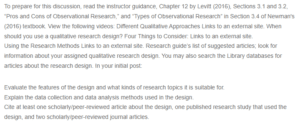Narrative Research
Under qualitative research design, a researcher can employ different research designs to obtain relevant information, including ethnography, grounded theory, narrative research, and phenomenology. According to Newman (2016), the nature of a research study and the data collection type determines the research design employed. Narrative research is a qualitative design that entails obtaining information about a research subject based on the story of one individual. The most common data collection method under narrative research design is in-depth interviews. However, Clandinin, Cave, and Berendonk (2017) suggest that other data collection methods, such as observation, can also be used. The method relies on information obtained from the participant’s life story and experiences associated with the phenomenon under interest. It is important to note that information should be obtained directly from the person experiencing the phenomena under study.
Data analysis methods employed in narrative research include thematic analysis, where one or more realities are identified and situated in the research context. Narrative research can be used to research topics that examine people’s lives. Among the merits of the design is that it provides an in-depth understanding of a situation under study (Clandinin, Cave, & Berendonk, 2017). It also enables the researcher to uncover insightful historical issues never recorded elsewhere. However, the method is time-consuming and requires the researcher to have adequate research time. For instance, a study by Francis (2018) conducted narrative research to understand the experiences of being a victim of gun violence. Other topics that can be investigated using the method include the experiences of persons living with disabilities, an individual’s experiences living with an underlying health condition, and a parent’s life away from their children, among others.
References
Clandinin, D. J., Cave, M. T., & Berendonk, C. (2017). Narrative inquiry: a relational research methodology for medical education. Medical Education. 51(1):89-96. doi: 10.1111/medu.13136.
Francis, M. (2018). A Narrative Inquiry into the Experience of Being a Victim of Gun Violence. Journal of Trauma Nursing, 25(6), 381–388. https://doi-org.ezproxy-f.deakin.edu.au/10.1097/JTN.0000000000000406
Newman, M. (2016). Research methods in psychology (2nd Ed.). San Diego, CA: Bridgepoint Education, Inc.
ORDER A PLAGIARISM-FREE PAPER HERE
We’ll write everything from scratch
Question

Narrative Research
To prepare for this discussion, read the instructor guidance, Chapter 12 by Levitt (2016), Sections 3.1 and 3.2, “Pros and Cons of Observational Research,” and “Types of Observational Research” in Section 3.4 of Newman’s (2016) textbook. View the following videos: Different Qualitative Approaches Links to an external site. When should you use a qualitative research design? Four Things to Consider: Links to an external site.
Using the Research Methods Links to an external site. Research guide’s list of suggested articles; look for information about your assigned qualitative research design. You may also search the Library databases for articles about the research design. In your initial post:
Evaluate the features of the design and what kinds of research topics it is suitable for.
Explain the data collection and data analysis methods used in the design.
Cite at least one scholarly/peer-reviewed article about the design, one published research study that used the design, and two scholarly/peer-reviewed journal articles.

